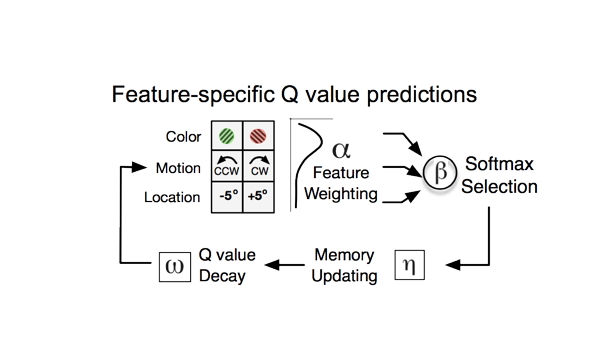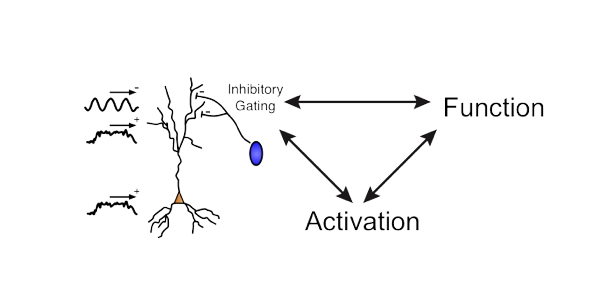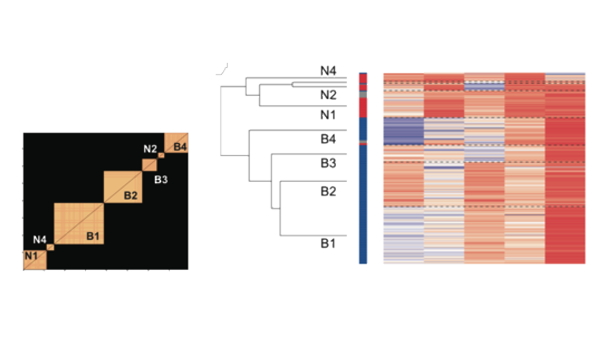News
A long-standing open question is how brain circuits learn what information is behaviorally relevant and should be attended. We have a new key insight to this question published in the paper “Adaptive Reinforcement Learning is causally supported by Anterior Cingulate Cortex and Striatum” (Neuron, pdf). We found that brief 0.3 s electrical stimulation at the […]
Our new paper shows that the flexible learning of attention sets is facilitated by noradrenergic receptor action. The paper “Noradrenergic alpha-2a receptor stimulation enhances prediction error signaling and updating of attention sets in anterior cingulate cortex and striatum” is published in Nature Communications was led by PhD alumnus Ali Hassani and found that neuronal firing […]
We published a new unity based software platform for profiling cognitive and motivational constructs in nonhuman primates and humans. The platform has multiple pre-configured tasks with some gamified features that makes them engaging to play for participants. Details are described and linked on the website: http://m-use.psy.vanderbilt.edu. The technical details are available in Watson et al. […]
We have a new major finding published at Neuron. We found that spiking in different areas (ACC, Striatum, LPFC) engage in ~20ms wide correlations, and that this coordinated activity has systematic time lags that correspond to the anatomical connectivity. These ‘baseline routing states’ are amplified during beta bursts, and switch directionality (between ACC and PFC) […]
We have new research out at PNAS about enhancing cognitive flexibility with highly selective allosteric modulation of the M1 muscarinic receptor (pdf: here)! Muscarinic receptors are known to mediate pro-cognitive effects of acetylcholine, but it has remained unclear whether they differentially affect the cognitive subfunctions of attentional filtering, set shifting, and learning. To clarify the […]
Acetylcholinergic Drug enhances attention at different dose as cognitive flexibilityWe tested how a cholinergic drug that is used to treat symptoms of dementia (donepezil, Arizept) affects cognitive abilities across multiple domains in monkeys. We found that donepezil showed stunning improvements of attentional filtering (less distraction) during visual search but at a different dose at it […]
We used focused ultrasound (FUS) sonication of the anterior cingualte and striatum to disrupt local processing during learning. FUS in ACC slowed down learning of atetntion sets – but only when the attentional demands were high and the task included the risk of loosing already attaiuned reward tokens. Under these cognitive and motivaitonally challenging conditions […]
We tested which model mechanisms best explain how six animals learn attention sets and found a common set of most-important behavioral mechanisms that account for learning success.When learning attention sets is easy value based reinforcement learning and working memory are powerful, but when learning problems are more complex learning is more efficient with attention and […]
We now published the hardware and software design for a novel Monkey Kiosk Station that provides cognitive enrichment and the ability to assess cognition with cage-based touchscreen tasks. The paper and its appendix with the technical details are available here.
Our new paper in eLife shows that a subclass of fast spiking interneurons in prefrontal and anterior cingulate cortex gamma synchronizes when uncertainty about cues and outcomes is resolved. This finding was possible by classifying narrow spiking neurons into fast and non-fast spiking classes and correlating their firing and spike-LFP synchrony during processing of attention […]
Our new paper shows that neurons in the striatum, anterior cingulate and prefrontal cortex encode learning variables in the phase of firing. We outline a powerful regression based analysis pipeline that revealed spiking activity of neurons relative to the phase of beta oscillations carries significant learning information during reversal learning. The paper can be downloaded […]
Our new paper shows how fast spiking interneurons in the striatum activate specifically when attention cues are learned. This is a rare paper where we succeed to isolate fast spiking interneurons in recordings from nonhuman primate anterior striatum while the animals performed a complex feature-based attentional learning task. Phd can. Kia Banaeie Boroujeni spearheaded the […]
Our new paper shows reliable Multi-Neuromodulator measurements in the awake nonhuman primate in prefrontal cortex, premotor cortex and the basal ganglia using a new chemical sensing probe. The probe uses principles of Solid-Phase-Microextraction and is a development by the SPME pioneer and collaborator Prof. Janusz Pawliszyn from the University of Waterloo. The paper can be […]
Our new open-source suite for experiments in virtual 3D environments is accepted at J Neurosci Methods and downloadable here. This suite is a complete software (using Unity3D) and hardware (using Arduinos) solution for conducting experiments in 3D environments. It allows running the same experiment in touchscreen, gaze control, or joystick mode (for humans and animals), […]
The lab has a first article published about the strength, latency and resonance patterns of connections between the anterior cingulate cortex and lateral prefrontal cortex of the macaque. This work was led by postdoc Veronica Nacher and is published in Brain Structure and Function. The paper identifies a novel electrical microstimulation protocol that can be […]
We hosted a superb 2018 CPPC (Computational Properties of Prefrontal Cortex) Workshop at Vanderbilt. The workshop attracted more than 60 emerging and established (neuro-)scientists about how the prefrontal cortex works – See the program and more at the www link CPPC2018. This year had special sessions on value-based decision making and uncertainty, social cognition, functional […]
A recent paper provides rare causal evidence that phase-specific stimulation during beta oscillation bursts lead to transient changes in effective (latent) connectivity. This finding and its potentially widespread implications are discussed in our paper Womelsdorf T, Hoffman K (2018) Latent Connectivity: Neuronal Oscillations Can Be Leveraged for Transient Plasticity. Current Biology. 28(16):R879-R882..
The lab has a new publication showcasing and describing details of Quaddles: A multidimensional 3D object set with parametrically-controlled and customizable features. Quaddles have 5+ feature dimensions, each with multiple possible feature values that can be parametrically morphed, making it possible to generate a near arbitrary number of unique objects. Thanks to Marcus and Milad […]
Our new publication (Oemisch et al. (2018) Feature Specific Prediction Errors and Surprise across Macaque Fronto-Striatal Circuits during Attention and Learning) provides the first 4-brain-area survey of how prediction error information in the anterior cingulate – ventral striatum and lateral prefrontal – caudate fronto-striatal loops relate to feature-based attention and learning. We found prediction errors […]
Thilo Womelsdorf, Kari Hoffman and eight more members of a large-scale initiative received a large-scale infrastructure support grant from the Canada Foundation for Innovation, amounting to $3.1M federal support. This extraordinary award allows establishing – in Toronto- an advanced neuroscience infrastructure for conducting research of brain activity and behavior close to real world settings. For a press release see […]
What an honour and incredible acknowledgment of our research – Thilo received the 2017 E.W.R. Steacie Memorial Fellowship Award with five fellow scientists in Canada and across the Natural Sciences and Engineering. This is one of the most prestigious awards for young scientists in Canada, celebrating the critical role of fundamental, basic research for driving […]
Theta and beta frequency range coherence between anterior cingulate cortex and frontal eye field indexes the successful preparation for anti-saccades and maintenance of working memory content – with larger ACC to FEF direction of granger causal information flow! These important findings is now published in Nature Communications by Sahand Babapoor-Farrokhran and Stefan Everling with contributions […]
Congratulations to Ali and Mariann for the first neuropharmacological contribution from our laboratory with the article A computational psychiatry approach identifies how alpha-2A noradrenergic agonist Guanfacine affects feature-based reinforcement learning in the macaque . This study first surveys all 14 different tasks that have ever been used with Guanfacine in nonhuman primate studies and than […]
Congratulations to Ben to win the York University 3 minute thesis competition in presenting his MSc graduation work ! Here is the University’s press release about the 2016 YorkU 3MT Winner ! Good luck from the laboratory when moving to the provincial level competition (still with only 3 minutes…for the whole thesis).
The 2015 BrainDay at Waterloo University hosted Thilo for a lecture for the neuroscience section. Brainday is a highly inspiring event organized by the Centre for Theoretical Neuroscience at Waterloo and the University to discuss brain topic from four different fields in a unifying daylong setting (Psychology, Philosophy, Systems Neuroscience, Theoretical Neuroscience). The talk at […]







